Peach leaf curl: control measures, methods of prevention and treatment
Your peach probably has reddened and twisted (curled) leaves after flowering. Or you have already had such a sad experience and want to know more about this dangerous fungal disease.
Indeed, the problem of curly peach leaves is relevant in almost all regions of this stone fruit crop, especially with a cool and humid climate.
Next, you will learn what leaf curl is, what are its symptoms (how it manifests itself) and, naturally, we will talk about measures to prevent and combat this fungal disease, what drugs exist to protect and treat peach from curly leaves.
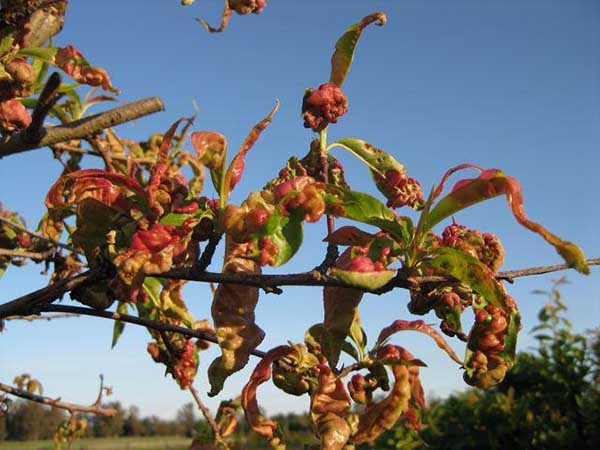
Content
What is peach leaf curl: signs of a fungal disease
Peach leaf curl - the most dangerous and harmful disease of this culture.
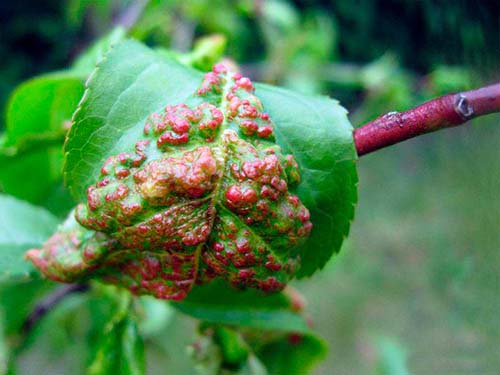
Taphrina deformans (Berk.) Tul is the causative agent of the disease causing curl in peach leaves.
The timing of infection of a peach with curly leaves falls on period of kidney swelling.
In addition to peach, apricot, nectarine and almond are the host plants on which the pathogen (fungus) can parasitize.
Conditions conducive to the emergence and distribution the pathogen that causes curliness of peach leaves is cool (+6 .. + 12 degrees) and humid weather (cold and damp climate).
Symptoms and signs of peach leaf curl disease:
- First, young, freshly blossoming leaves are affected, on the front side of which amber or reddish-pink bumpy spots (their surface becomes uneven and wavy).
- After a couple of weeks on the underside of the sheet formed white waxy bloom... This is the fruiting of the mushroom. In the future, such leaves turn brown and fall off.

- Next comes exposure of affected shoots, which usually starts at the bottom. From this, they (shoots) take the form of a brush, thicken, bend, acquire a yellowish tint. Then, starting at the top, part of the naked as a result of falling leaves shoots dry up, the rest - die at the first frost.
- Fruitdeveloping on two-year-old shoots affected by curliness, fall off.
The main danger of this fungal disease is that in the second year, infected trees may not bear fruit.

Measures and methods for the prevention of curly peach leaves
The following agrotechnical measures will allow you to prevent (at least reduce the likelihood) of the disease of the peach with curly leaves:
- The simplest and most economical tool - correct pruning... At the end of the first pruning, before bud break, you need to prune all annual branches 2-3 buds from the top. Most of all fungal spores winter here. This is the most unripe and painful part of the plant - hence the infection of healthy parts of the peach. Sometimes this procedure alone is enough to prevent curliness from appearing.
- Naturally, all cut off infected shoots must be removed from the site or burned.
By the way! The site has a detailed article about how to prune a peach in spring.
- Of course, disease resistant varieties should ideally be planted. But it should be understood that varieties completely resistant to curl do not exist, although in many characteristics of varieties they write about this.
- The general recommendation is to take full care of the peach: water and feed on time. Strong plants better resist diseases (Just do not overdo it with nitrogen, it is better to use complex mineral fertilizers, which, in addition to nitrogen, also contain a lot of potassium and phosphorus!).
Advice! If you have everything several peach treesthen you can independently remove and burn leaves affected by curl, in their place will be build up new young leaflets. Of course, this will only make sense if you cut off curled up leaves regularly, i.e. walk around the garden every morning and inspect every peach.
When and how to treat peach from curly leaves
Well, now let's talk about the direct processing of peach, its rules and timing. What schedule and pattern of spraying is better to adhere to, what preparations for the treatment of curly leaves to use.
How to properly spray trees
If you want the treatments to be as effective as possible and at the same time safe, you need to adhere to the basic rules and recommendations:
- While preparing solutions and spraying treesobserve safety precautions.
If the packaging of the product says that you need to wear special clothes (dressing gown, overalls, raincoat), goggles and a respirator, rubber gloves, then you need to wear it.
- Spraying is desirable in the morning (after dew has dried) or late at night (after sunset).
- It is only necessary to process trees in dry and calm weather.
- All prepared solutions should be pass through a filter meshso as not to clog the sprayer.
- Suitable for dissolving almost all drugs room temperature water (for vitriol, it is advisable to use hot water, about + 40-50 degrees).
If you are using a biological productthen water better to take settled or filtered, i.e. chlorine free.
- At each stage, you can use like the same drugs (for the sake of economy) and new (wherein need to change active ingredient, so that there is no addiction - it will be more effective). Or alternate (use alternately).
During each phase, you can carry out not 1, but 2 or more treatmentsif it is indicated in the instructions for the preparation.
Terms and scheme of processing
Peach Treatment Schedule Against Leaf Curl:
- On the swelling buds, but before they bloom, i.e. sprinkle on unopened (so-called stage of the "green cone")... To do this, use the most simple contact protective agents based on copper sulfate — copper sulfate or Bordeaux liquid (3% solution, then only 1%)
- In phase "Rose bud" ("Bud separation") - you can continue to use simple contact protective action based on copper sulfate (copper sulfate or Bordeaux liquid). Also drugs based on copper oxychloride - Abiga-peak, Hom, Oksikhom (the last one is already systemic contact fungicide), and even better to use systemic healing - Topsin-M or systemic protective-healing - Horus or Skor (Rayok, Guardian), Bayleton, Stroby, Ridomil Gold (system-contact), Tilt (Forecast).
Note! Horus works greatat low positive temperatures (+5 .. +15), aSkor (or Raek, Guardian)on the contrary, it works betterat higher temperatures (from +15)... In short, act according to the weather.
- After flowering (as soon as all the flower petals fall off) - similar means, i.e. contact protective copper-based, as well as Delan and systemic fungicides of protective and curative action - Horus, Skor (Rayok, Guardian), Bayleton, Stroby, Ridomil Gold (system-contact), Tilt (Forecast).
- 10-14 days after flowering and previous treatment - similar drugs.
You can of course use and bio-fungicides to protect the peach from curly leaves, and it is advisable to prepare exactly tank mixtures. For example, Planriz + Trichodermin + Pentafag-C (for pre-flowering treatments) and Planriz + Trichodermin + Gaupsin (after flowering). If you like Fitosporin (better after flowering), then it is recommended to use it separately.
Thus, to ensure that your peaches are protected from leaf curl, you will need 2-3 preventive treatments before flowering and 2 after flowering.
By the way! And after fruiting and harvesting, it is very desirable to carry out autumn peach eradication spraying.
Chemicals
Advice! During the growing season, you can use either one drug (for the sake of economy), or various means (at the same time, they should not only have a different name, but also be different active substance - so that the causative agent of the disease does not develop addiction or resistance). Or you can alternate (use alternately).
For the treatment of peach from curly leaves, as a rule, the following preparations are used - fungicides (the active ingredients, the method of penetration and the nature of the effect are given in brackets):
- Bordeaux mixture -contact fungicide protective actions based on copper sulfate and calcium hydroxide - lime (3% Bordeaux liquid solution - before bud break and 1% - at the “rose bud” stage);
By the way! The site has a detailed article about how to prepare and apply Bordeaux liquid.
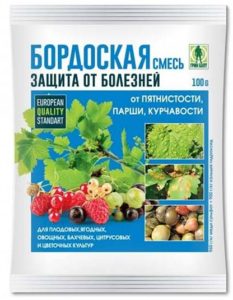
- Copper sulfate - contact fungicide protective actions based on copper sulfate;
Advice! More details about the features of the use of copper sulfate readin this material.
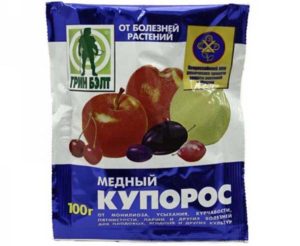
Note! It is advisable to treat peaches with copper-containing preparations only before bud break, otherwise the leaves may burn and shatter (however, a 1% solution, as a rule, does not cause anything like this). Of course, then new leaves will grow ... but this will not be good for the tree.
- Abiga peak - protective contact fungicide based copper oxychloride;
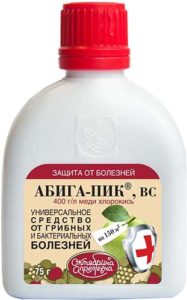
- Hom - contact fungicide protective actions based on copper oxychloride;
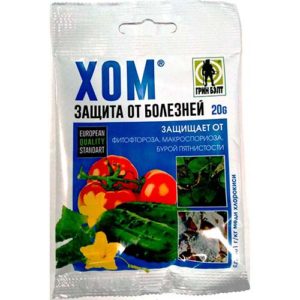
- Oxyhom - contact systemic fungicide protective actions based on copper oxychloride and oxadixyl;
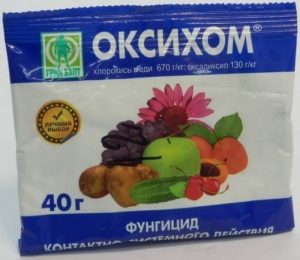
- Delan - contact fungicide, protective and curative actions based on dithianona);
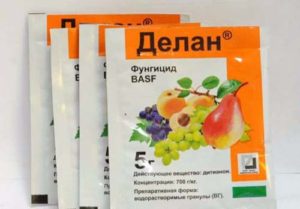
- Topsin-M - systemic contact protective fungicide actions based onmethyl thiophanate;
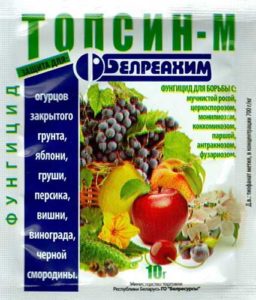
- Horus - systemic fungicide of protective and curative action based cyprodinil;
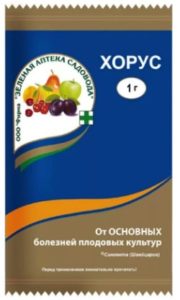
- Speed - systemic fungicide of protective and curative action based difenoconazole;
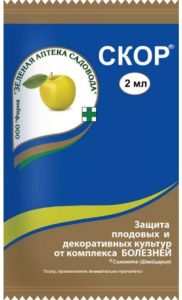
Some gardeners claim that it is very effective to make a tank mix. Horus + Haste!
In general, Horus and Skor have gained the greatest recognition in the fight against curly leaves.
- Rajok - systemic fungicide of protective and curative action based difenoconazole;
Speed = Rayok = Guardian.
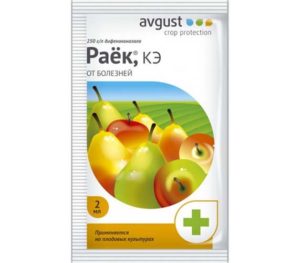
- The keeper - systemic fungicide of protective and curative action based difenoconazole;
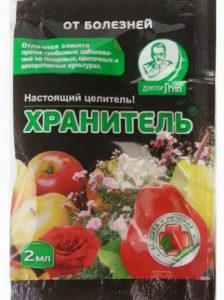
- Ridomil Gold - systemic contact fungicide, protective and curative actions based on mancozeb and mefenoxam;
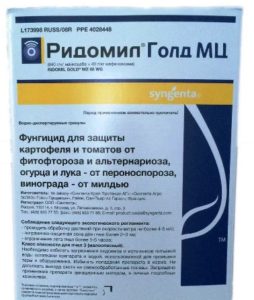
- Bayleton - systemic fungicide protective and healing action based on triadimephone;
- Strobe - systemic fungicide protective and healing actions based on kresoxim-methyl;
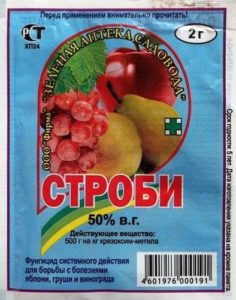
- Tilt-250 (systemic fungicide protective and healing actions based onpropiconazole, against curly leaves, powdery mildew);
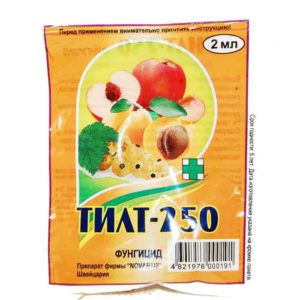
Tilt and Forecast are analogs with the same active substance (like Skor and Raek).
- Forecast (systemic fungicide protective and healing actions based onpropiconazole, against curly leaves, powdery mildew).
Advice! Carefully study the instructions: the scope of the drug (against what diseases), terms (including waiting), dosage.
Video: preparations against curly peach
Biological agents
To protect the peach from leaf curl, you can try the following biological products:
It is worth understanding! Biological agents are mostly recommended for prophylactic purposes or at very early stages of the development of the disease, when the lesion is still insignificant.
- Planriz or Rizoplan (Pseudomonas fluorescens strain AP-33, contact protective bio-fungicide);
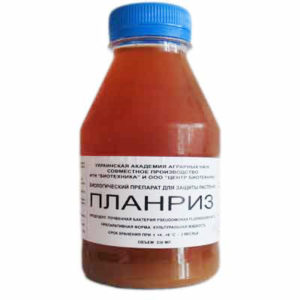
- Trichodermin or Trichoderma Veride (Trichoderma lignorum or veride, strain 471, contact protective bio-fungicide);
Advice! The effectiveness of Trichodermina can be enhanced when combined with the biological product Planriz (Rizoplan).
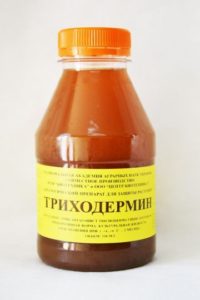
- Pentafag-S (contains virions of five strains of bacterial viruses, as well as biologically active substances; contact bio-fungicide of protective and therapeutic action);
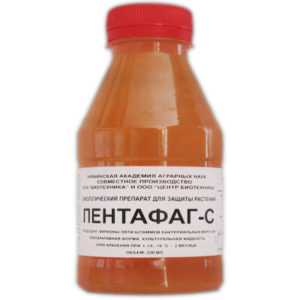
Residents of Ukraine can use such a biological preparation as Mikosan B.
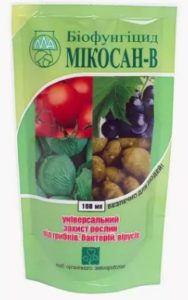
- Fitosporin (Bacillus subtilis strain 26 D, systemic fungicide of protective and curative action);
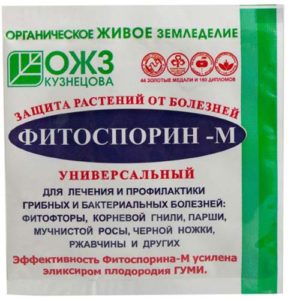
- Gaupsin (insectofungicide).
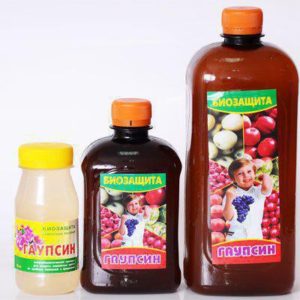
Thus, if you are serious about the preventive measures to protect the peach from curly leaves (what drugs to use for processing - now you know), then with a high degree of probability you will be able to overcome this annoying disease and still collect a decent harvest of sweet and tasty peaches ... Just do not despair, fight to the end!
Video: peach disease - leaf curl


Can Peach be sprayed in spring with UREA?
If for the purpose of early spring eradication spraying (before or at the beginning of budding) to "burn out" the wintering stages of pests, then why not, as well as for foliar feeding, but later (by leaves) and in a much lower concentration.
IS IT POSSIBLE TO USE THE MIXTURE OF CHORUS = SOURCE TO FIGHT PEACH TUMBLING AND WHEN IT IS POSSIBLE TO USE. ONLY LEAVES APPEARED ON A PEACH AND HOW CORRECTLY MIX SCOR WITH CHORUS
Yes, you can prepare a tank mix (many do just that). But remember that Horus is most effective at low temperatures (from 5 degrees), and Speed, on the contrary, works at higher temperatures - from +15 degrees. Therefore, it seems to me, it makes sense to process it with a tank mixture at temperatures above 15 degrees (as the manufacturer claims, Horus copes well with diseases even at +25). But, as a rule, Horus is used before flowering, and Skor - after.
There are no peculiarities when mixing. Take a separate container, pour a little water (1-3 liters), first add one drug (at the rate), stir, then the second (at the rate), top up to the required volume (10 liters, not 20).
What I do not process, how I planted I can not get rid of the curl, for 3 years
Very sorry((
Trimming the tops, picking off the first infected leaves don't help at all?
Maybe you should try planting a new, more resistant variety? Suddenly he will be able to better withstand the disease in your conditions (at least not so much amazed).